Menus
- Sports tourers from Honda and BMW put to the test
- MOTORCYCLE scoring / test result
- Technical specifications
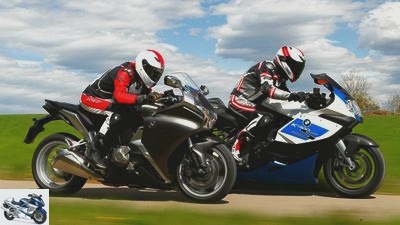
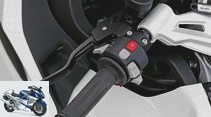
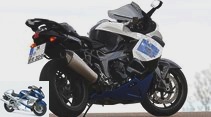
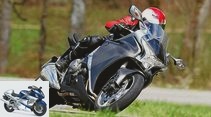
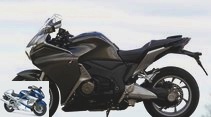
13 photos
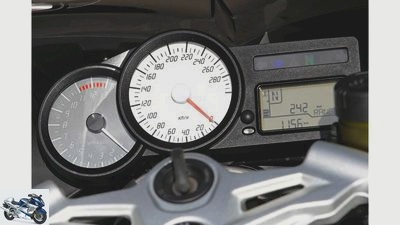
1/13
Comparative test of big bikes: in the display of the sporty styled cockpit of the BMW K 1300 S HP, all imaginable information can be called up at the push of a button.
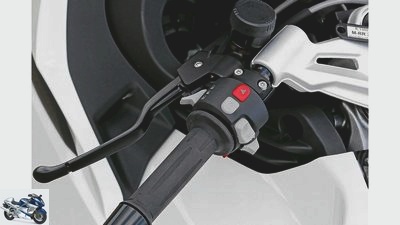
2/13
Big Bikes comparison test: Flip book on the BMW K 1300 S HP: Info button for selecting the display, ABS / ESC can be switched off and the suspension setup is selected using the ESA button.
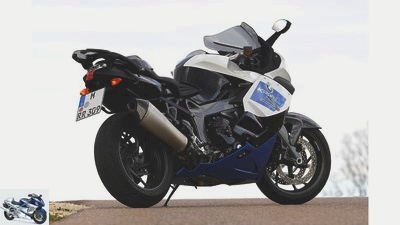
3/13
Comparative test of big bikes: The BMW K 1300 S HP is a noble bike that hardly shows any significant weaknesses, at a steep price.
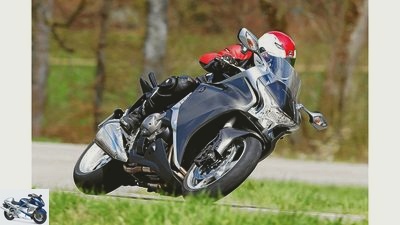
4/13
Big bike comparison test: The Honda VFR 1200 F DCT cannot hide its displacement and 20 kilograms extra weight.
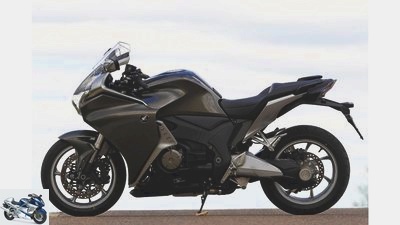
5/13
Comparison test of big bikes: Honda has largely kept its word with the VFR 1200 F DCT and learned from criticism. The torque hole at the very bottom is almost gone, consumption has fallen and the standard equipment has been increased significantly.
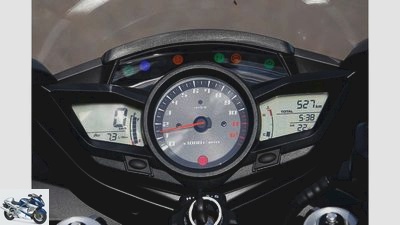
6/13
Comparison test of big bikes: The cockpit of the Honda VFR 1200 F DCT is clear and easy to read. It now also offers a consumption display and thus closes the last information gap.
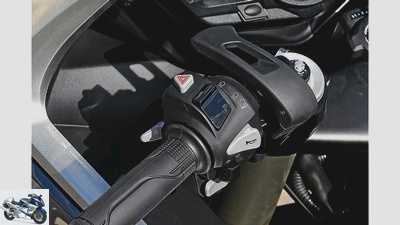
7/13
Comparison test of big bikes: The parking brake lever of the Honda VFR 1200 F DCT is for downhill parkers. The driver can shift up or down with a push button.
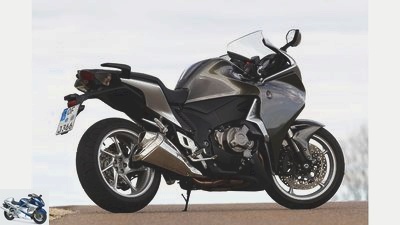
8/13
Big bike comparison test: The Honda VFR 1200 F DCT is a gentle sports touring bull with its own style.
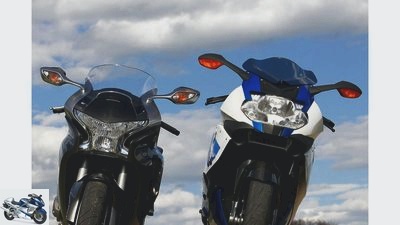
9/13
Big bike comparison test: the BMW K 1300 S HP and the Honda VFR 1200 F DCT from the front.
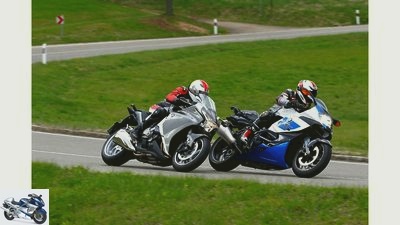
10/13
Comparative test of big bikes: the BMW K 1300 S HP is expensive for its advantages. When it comes to price-performance, the Honda VFR 1200 F DCT is the winner.
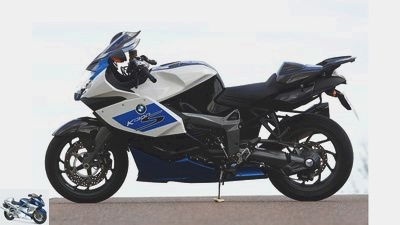
11/13
Comparative test of big bikes: The luxury version of the BMW K 1300 S with the HP package offers everything that is good and expensive. Its main assets, however, are still the extremely powerful engine, the amazingly handy, electronically adjustable chassis and the snappy brakes.
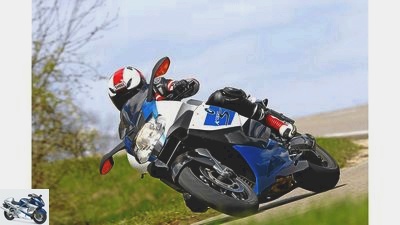
12/13
Big Bikes comparison test: The high-end version of the BMW K 1300 S HP costs almost 4,000 euros extra.
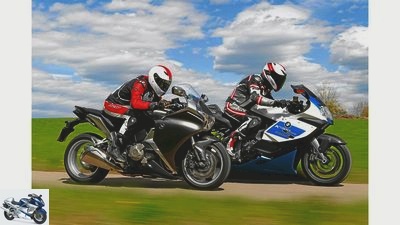
13/13
Comparative test of big bikes: the BMW K 1300 S HP and the Honda VFR 1200 F DCT in the test.
Comparison test: BMW K 1300 S HP against Honda VFR 1200 F DCT
Sports tourers from Honda and BMW put to the test
They offer powerful engines for sporty driving performance, a stylish outfit and raise the exciting question of who is ahead in the sports tourer upper class. Can the freshly revised Honda of the BMW in classy HP trim hand the bubbly?
Amazed, confused. The drivers standing next to them are unsure about the one-handed traffic light start, what kind of vehicle is driving next to them. Fiddling with the visor with his left hand, the driver sets the two-wheeler in motion by turning the accelerator. So a scooter with automatic? The rear tires are too wide, the acceleration is too violent. How should motorists who are not familiar with the subject also suspect that there is something like this Honda sports tourer with a 1200cc engine and over 170 hp? And DCT – the dual clutch transmission, which makes the clutch lever superfluous and enables the driver to be on the road either in leisurely D mode or in sporty S mode without having to clutch or shift.
If you don’t want to be completely incapacitated when it comes to gear selection, you can also shift up or down manually using the touch button on the left handlebar switch. So far, so well known – the VAfter all, the FR 1200 F with DCT gearbox has been around since 2010. Time for a revision and improvements in some important points, thought Honda and gave the VFR fans the 2012 version. What’s new about it? Well, the often criticized, somewhat weak torque curve between 2000 and 4000 tours should now have been improved, the slump smoothed, and in the same breath the fuel consumption also reduced. In connection with the tank volume, which has grown from 18.5 to 19 liters, this increases the possible range, and consumption is now also displayed in the cockpit. A traction control that can be switched off ensures more safety, and a new seat cover increases the slip resistance. The suitcase and the main stand (unfortunately not yet mounted on the test bike) serve the everyday and travel suitability, the three-year guarantee should reassure the driver.
Buy complete article
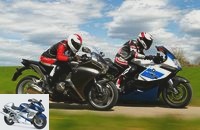
Comparison test: BMW K 1300 S HP against Honda VFR 1200 F DCT
Sports tourers from Honda and BMW put to the test
BMW K 1300 S HP.
Did the revised engine setup bring anything? Sixth gear, 60 km / h, full throttle: where the mechanically rougher running and robust-sounding BMW tears off spontaneously and resolutely, as if you were in fourth instead of sixth, the Honda is still a little sleepy on the ropes. Not as deep as before, as the performance curve and the torque values attest, but subjectively one would have expected more. The heretical question arises as to where all the 1237 cubic centimeters are actually. However, it is no longer a hole, at most a short break, which can be determined at around 3000 rpm. Above the 4000 mark, things are progressing appropriately, at around 5500 rpm there is the said second wind and then there is little to complain about when it comes to revving up to over 10,000 rpm. However, the Honda has no chance against the brute thrust of the BMW in-line four.
The VFR cannot hide its displacement shortage and its 20 kilograms extra weight. Sound and vibrations come across as strongly muffled, thanks to the 28 degree crank pin offset of the front and rear cylinders, the V4 can do without a balancer shaft. The Honda also manages to convert the gas command into propulsion a little more smoothly and without jerks than the BMW. Their cardan reacts to hard load changes with noticeable reactions, the VFR strand obviously works with less play here. A bit of getting used to remains with the Honda, however, the audible clinking in the double clutch transmission when driving at constant speed or subtle changes in pace when strolling. The provision of the next higher or lower gear pair apparently causes this slight clacking, which can, however, simply be turned off by switching to manual mode and simply staying in the gear that you selected.
If you just want to jet through the country with confidence and want to concentrate on the landscape instead of switching, the DCT version is the best choice. With moderate opening of the gas tap, the driver reaps ICE-like, gentle propulsion without ever feeling a shift jolt, accompanied by the steady hum of the V4 and the howling of the gear wheels. In D mode, the DCT gearbox changes gear steps early, is engine-friendly and reduces fuel consumption. The modifications to the engine actually seem to bring about the promised economy, in any case, the determined highway consumption of exactly five liters per 100 kilometers can be considered pleasantly modest. This value should certainly not be achieved in S mode. The control unit, which “learns” the pilot’s driving style, often persists in the engaged gear for a long time, often for too long, without shifting up, even if the pilot does not want to be on the move at full speed.
In addition, the system shifts down quite early; the motor’s braking torque, which is often missing in D mode, is all too often used here. So if you can’t really get used to both modes, you like to use the option of simply stepping up and down manually using a button without jerking and without coupling.
The BMW automatic gearshift, which is standard on the HP version, also slams into the next gear when accelerating at full speed and with virtually no interruption in tractive power (a slight pull with the foot is enough), so it does its job brilliantly and also gives the driver the option of downshifting or to intervene in tight bends even with gentle clutch support.
Honda VFR 1200 S DCT.
The assistance systems, i.e. ABS and traction control, rarely have to intervene on both bikes. The VFR now also offers the latter as standard. In the case of both opponents, the last-mentioned system intervenes late in the event of excessive gas tearing in the lower gears, but reliably and temporarily reduces the engine output. If speed is to be destroyed, you can also rely on both braking systems. The semi-integral system of the Honda (the foot brake activates one of the six pairs of pistons at the front, the pull on the hand lever activates the other five) proves to be more finely adjustable and offers the clearer pressure point, the BMW brake decelerates more acutely, its ABS regulates harder and more clearly noticeable, the Bavarian creates the shorter braking distances. It is not only in this respect that the K 1300 S mimes the sportswoman in a duel, the BMW also makes clear statements when it comes to steering behavior and cornering speed. It is better not to try to find out how easy it is to lean on regular roads, whereas the Honda pegs scratch the asphalt more often. At just under 260 kilograms, the HP is not a lightweight either, its long wheelbase does the rest, but it can be shooed around corners with astonishing agility, steers precisely and does not stand up noticeably when braking.
The Honda, which unfortunately competes on the earlier criticized Bridgestone BT 021 tires, is completely different. It wants to be pushed in an inclined position, needs more effort (not least because of its high weight) when turning it quickly, stands up drastically on bumps and especially when the brake lever is pulled lightly. The VFR on Dunlop Roadsmart has proven that it can be done better, namely more nimbly and harmoniously.
There is not much to complain about about the quality of the spring elements. The specimens of the ESA-equipped BMW can be adjusted with the push of a thumb. Even in the softest “comfort” level, they are still quite tight, but do a good job in front and behind. The Honda fork (only adjustable in preload and rebound) parries small bumps such as rough holes well, but the damping of the rear shock strut reaches its limits, especially with a passenger. The VFR does not allow too much payload anyway, at just 184 kilograms it is quite meager for a sports tourer. In terms of equipment, on the other hand, it doesn’t have to be blamed anymore – both the 2012 Honda and the BMW in HP versions are lavishly dressed up. But style and class also have their price, especially at BMW.
MOTORCYCLE scoring / test result
Test winner: BMW K 1300 S HP.
engine
There is no herb against the brawny row four of the BMW. It combines rich torque with great revving, ensures excellent driving performance and is nowhere to be ruffed. The somewhat more sophisticated Honda V4 now offers a fuller performance characteristic at the bottom, but always lags behind the BMW. In addition, the VFR seals off at 250 km / h, where the Bavarian cheerfully continues to gain. That costs points.
Winner engine: BMW
landing gear
Two sports tourers: the BMW focuses on sport, the Honda on tourers. The very agile BMW rolls on well-coordinated Metzeler soles and cannot be fooled when it comes to handling, lean angle and chassis adjustment (ESA). The slightly more comfortable Honda could actually do better, but on the mounted Bridgestone tires it looks stiff, cumbersome and stands up strongly.
Chassis winner: BMW
everyday life
A head-to-head race in everyday suitability. With its standard equipment extended for 2012, the Honda scores valuable points. Somewhat better wind protection and better visibility in the mirrors of the Honda stand against the better light and the easier maintenance (oil check) of the BMW. If the VFR did not afford the failure with the (meager) payload, it could win this category outright.
Winner everyday life: BMW
security
The effect of the BMW brakes is simply terrific. The Honda stoppers don’t seem so brutal, but they can be dosed a little better and provide clearer feedback. The tires are again to blame for the rough positioning when braking.
Safety winner: BMW
costs
The Honda offers a three-year guarantee. Consumption, inspection and maintenance costs are almost the same.
Winner cost: Honda
Price-performance
BMW is paying disproportionately high prices for its point advantage. The Honda is a fair offer.
Price-performance winner: Honda
| Max points | BMW | Honda | Overall rating | 1000 | 750 | 725 | placement | 1. | 2. | Price-performance note | 1.0 | 2.8 | 1.9 |
Honda VFR 1200 S DCT.
MOTORCYCLE test result
1st BMW K 1300 S HP
The Nobel version of the K 1300 S with the HP package offers everything that is good and expensive. Its main assets, however, are still the extremely powerful engine, the amazingly handy, electronically adjustable chassis and the snappy brakes. A noble bike that hardly shows any significant weaknesses, at a steep price.
2. Honda VFR 1200 F DCT
Honda has largely kept its word and learned from criticism. The torque hole at the very bottom is almost gone, consumption has fallen and the standard equipment has been increased significantly. The DCT transmission can be used variably, the good driving behavior depends heavily on the tires. A gentle sport touring bull with his own style.
Technical specifications
BMW K 1300 S HP and Honda VFR 1200 S DCT.
| BMW | Honda | engine |
| design type | Four-cylinder, four-stroke in-line engine | Four cylinder four stroke 76 degree V engine | injection | Ø 46 mm | Ø 44 mm |
| coupling | Multi-disc oil bath clutch | Double clutch | Bore x stroke | 80.0 x 64.3 mm | 81.0 x 60.0 mm |
| Displacement | 1293 cm3 | 1237 cm3 | compression | 13.0: 1 | 12.0: 1 |
| power | 129.0 kW (175 hp) at 9250 rpm | 127.0 kW (173 hp) at 10,000 rpm | Torque | 140 Nm at 8250 rpm | 129 Nm at 8750 rpm |
| landing gear | frame | Bridge frame made of aluminum | Bridge frame made of aluminum |
| fork | Double longitudinal control arm made of aluminum | Upside-down fork, Ø 43 mm | Steering damper | Yes | no |
| Brakes front / rear | Ø 320/265 mm | Ø 320/276 mm | Assistance systems | Partly integral braking system with ABS | Partly integral braking system with ABS |
| bikes | 3.50 x 17; 6.00 x 17 | 3.50 x 17; 6.00 x 17 | tires | 120/70 ZR 17; 190/55 ZR 17 | 120/70 ZR 17; 190/55 ZR 17 |
| Tires | Metzeler Sportec M3 | Bridgestone BT 021 “N” | Dimensions + weights |
| wheelbase | 1585 mm | 1545 mm | Steering head angle | 60.4 degrees | 64.5 degrees |
| trailing | 104 mm | 101 mm | Front / rear suspension travel | 115/135 mm | 120/130 mm |
| Seat height ** | 830 mm | 800 mm | Weight with full tank ** | 258 kg | 280 kg |
| Payload ** | 202 kg | 183 kg | Tank capacity / reserve | 19.0 / 4.0 liters | 19.0 / 0 liters |
| Service intervals | 10000 km | 12,000 km | price | 20090 euros | 14990 euros |
| Price test motorcycle | 20801 euros | 15990 euros | Additional costs | 263 euros | 355 euros |
| MOTORCYCLE readings | Top speed * | 285 km / h | 250 km / h |
| acceleration | 0-100 km / h | 2.9 sec | 3.9 sec |
| 0-140 km / h | 4.3 sec | 5.7 sec | 0-200 km / h | 7.8 sec | 10.1 sec |
| Draft | 60-100 km / h | 3.3 sec | 4.4 sec |
| 100-140 km / h | 3.2 sec | 4.2 sec | 140-180 km / h | 3.4 sec | 4.3 sec |
| Consumption highway | 5.1 liters / Super Plus | 5.0 liters / super | Reach country road | 373 km | 380 km |
Related articles
-
Comparison test BMW K 1300 S, Honda VFR 1200 F DCT and Yamaha FJR 1300 AS
Arturo Rivas 30 pictures Rivas 1/30 comparison test: Tourer with shifting aids – BMW K 1300 S, Honda VFR 1200 F DCT and Yamaha FJR 1300 AS. Rivas 2/30 …
-
Comparison test of the sports tourers from BMW and Honda
fact 12 pictures fact 1/12 Top brakes: radially screwed six-piston stoppers, ABS and integral actuation. fact 2/12 Builds compact and very narrow: the …
-
factstudio.de 29 photos fact 1/29 One against all. Ducati SuperSport S in comparison test with Suzuki GSX-S 1000 F, Kawasaki Z 1000 SX, Honda VFR 800 F…
-
Comparison test: Benelli TnT R 160, BMW K 1300 R, Ducati Streetfighter S
fact comparison test: Benelli TnT R 160, BMW K 1300 R, Ducati Streetfighter S The strongest and most extravagant naked bikes Life is too short to …
-
BMW R 1200 R and Ducati Monster 1200 in a comparison test
Gargolov 30 pictures Gargolov 1/30 Ducati Monster 1200 and BMW R 1200 R. Gargolov 2/30 … modern headlights, … Gargolov 3/30 Ducati Monster 1200 and …
-
Comparison test two-cylinder: BMW R 1200 R, Buell Lightning XB12Ss and Moto Guzzi Griso 8V
fact comparison test two-cylinder: BMW R 1200 R, Buell Lightning XB12Ss and Moto Guzzi Griso 8V Big Twins only 1170, 1202, 1151 ?? these…
-
Comparison test: Honda VFR 800 against VFR 1200 F
fact 25 pictures fact 1/25 old against new: Honda VFR 800 (in the foreground) against the new VFR 1200 F. fact 2/25 Honda VFR 1200 F (right) against the …
-
Honda VFR 800 F and Honda VFR 1200 F in comparison test
fact 8th photos fact 1/8 Clear distance: the two V4 engines always separate between 35 and over 50 Newton meters. fact 2/8 Honda built its first racing…
-
Sports tourer BMW K 1300 S, Honda VFR 1200 F and Suzuki GSX-S 1000 F in the test
fact 30th photos fact / Joachim Schahl 1/30 Sports Tourer? Do they still exist? But of course! It may be that Multistrada, Adventure and Co. have badly…
-
Test: Honda CB 1300, Suzuki GSX 1250 FA and Yamaha FZ1 Fazer
fact Comparison test: Japanese sports tourers Four disguised big bikes on tour Content of Knees on the ground, kilometers tearing – Kraftmeier disguised…